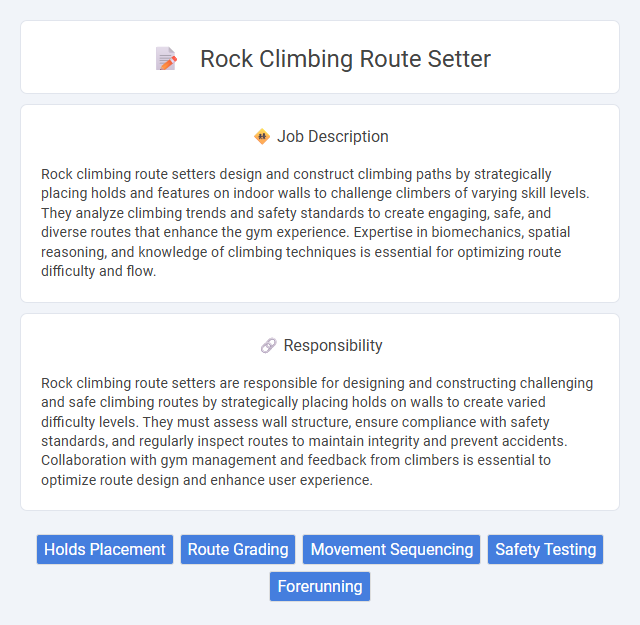
Rock climbing route setters design and construct climbing paths by strategically placing holds and features on indoor walls to challenge climbers of varying skill levels. They analyze climbing trends and safety standards to create engaging, safe, and diverse routes that enhance the gym experience. Expertise in biomechanics, spatial reasoning, and knowledge of climbing techniques is essential for optimizing route difficulty and flow.
Individuals with strong physical fitness, good upper body strength, and excellent spatial awareness are likely suitable for a rock climbing route setter job. Those who enjoy problem-solving, have creativity, and can work safely at heights may find this role aligns well with their skills. People prone to fear of heights or lacking stamina might face difficulties adapting to the job's physical and mental demands.
Qualification
A rock climbing route setter must possess strong knowledge of climbing techniques, safety standards, and equipment to design challenging and safe routes. Certifications from organizations like the American Mountain Guides Association (AMGA) or International Federation of Sport Climbing (IFSC) improve employability and demonstrate expertise. Physical fitness, creativity, and experience in both indoor and outdoor climbing environments are essential qualifications for this role.
Responsibility
Rock climbing route setters are responsible for designing and constructing challenging and safe climbing routes by strategically placing holds on walls to create varied difficulty levels. They must assess wall structure, ensure compliance with safety standards, and regularly inspect routes to maintain integrity and prevent accidents. Collaboration with gym management and feedback from climbers is essential to optimize route design and enhance user experience.
Benefit
A rock climbing route setter job likely offers physical health benefits by encouraging active movement and strength building. It may provide creative satisfaction through designing challenging and varied climbing routes that enhance climbers' experiences. Opportunities for community engagement and teamwork could also be part of the role, improving social connections within the climbing environment.
Challenge
Rock climbing route setters likely face the challenge of designing routes that balance difficulty and safety while encouraging skill progression for various climber levels. The job probably requires creativity and problem-solving to craft unique, engaging routes that prevent monotony and maintain climber interest. Physical endurance and detailed knowledge of climbing techniques may also be critical to effectively setting diverse and challenging routes.
Career Advancement
Rock climbing route setters develop essential skills in route design, safety protocols, and problem-solving, positioning themselves for roles such as lead route supervisor or gym operations manager. Gaining certifications from recognized organizations, like the American Mountain Guides Association (AMGA), enhances credibility and opens opportunities in competitive climbing gyms or outdoor expedition companies. Mastery in route setting combined with leadership experience can lead to career advancement into professional training, judging competitions, or designing courses for international climbing events.
Key Terms
Holds Placement
Rock climbing route setters specialize in holds placement to create challenging and safe routes for climbers of all skill levels. Precise positioning of holds influences the difficulty, flow, and variety of movements, requiring a deep understanding of climbing techniques and body mechanics. Effective holds placement enhances climber engagement and prevents injury by ensuring proper weight distribution and grip options.
Route Grading
Route setters specialize in designing and constructing climbing routes with specific difficulty levels to challenge climbers and ensure safety. Route grading involves assessing factors such as hold size, spacing, angle, and technical moves to accurately assign difficulty ratings like V-scale for bouldering or YDS for sport climbing. Precise route grading supports climbers in selecting appropriate challenges and fosters skill development within climbing gyms and outdoor climbing areas.
Movement Sequencing
Rock climbing route setters specialize in designing and arranging holds to create challenging movement sequences that test climbers' strength, balance, and technique. They analyze biomechanics and spatial relationships to develop fluid, progressive sequences that flow naturally while maximizing safety and difficulty. Expertise in movement sequencing enhances climbers' experience by promoting skill development and varied physical engagement on indoor and outdoor climbing walls.
Safety Testing
Rock climbing route setters play a crucial role in ensuring the safety of climbers by conducting rigorous safety testing on all holds, anchors, and equipment used in the climbing gym or outdoor routes. They perform detailed inspections for wear and structural integrity, simulate various climbing scenarios, and verify that all placements meet industry safety standards such as those set by the Climbing Wall Association (CWA). Consistent safety evaluations and immediate correction of potential hazards help prevent accidents and maintain a secure climbing environment.
Forerunning
Forerunning in rock climbing route setting involves testing new routes to ensure they are safe, challenging, and enjoyable for climbers. This process requires in-depth knowledge of climbing techniques, hold placements, and route difficulty grading to provide valuable feedback for adjustments before final installation. Forerunners play a critical role in maintaining route quality and climber safety within climbing gyms and competitions.
 kuljobs.com
kuljobs.com